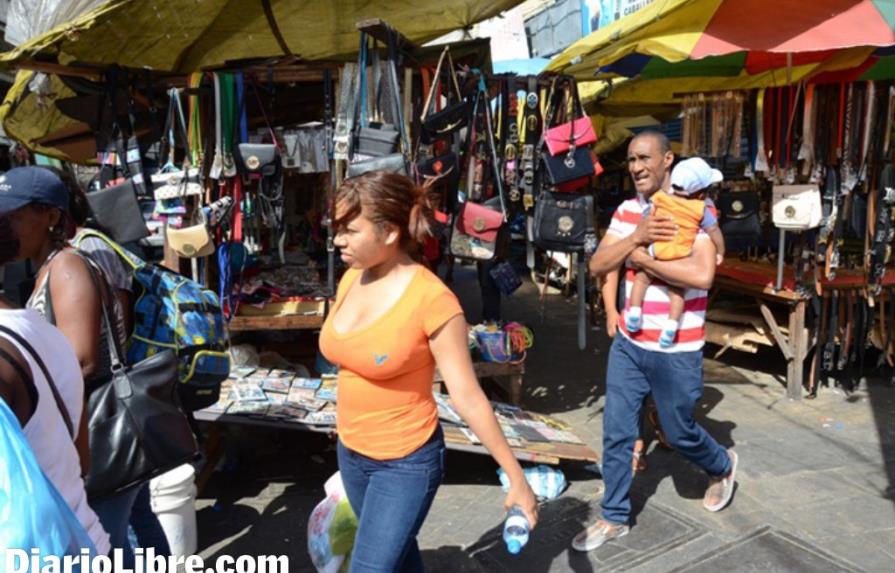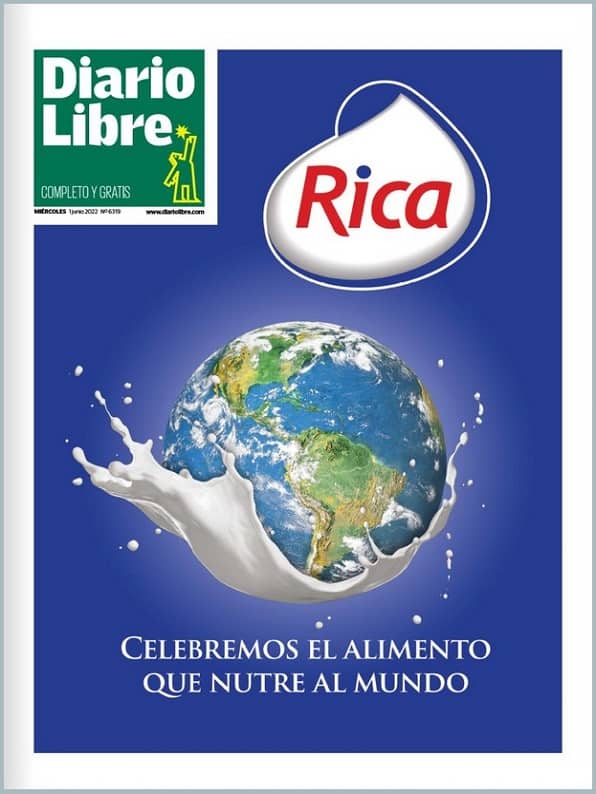Streets and corners converted into markets
They offer everything from lettuce, shoes, and even pets

SANTO DOMINGO. The intersections of the important avenues of Greater Santo Domingo have been converted into markets. Dozens of street vendors offer fruits, staples, articles for personal hygiene, clothes, accessories and even animals, in picturesque sales that increase the inconveniences of vehicular as well as pedestrian traffic.
The corners formed by the Nicolas de Ovando and Maximo Gomez avenues and Duarte at the corner of Paris, in the National District, as well as Hermanas Mirabal at the intersection of Charles de Gaulle in Villa Mella, in North Santo Domingo, and 27 February at the corner of Isabel Aguiar in West Santo Domingo, are the areas most affected and a sample of the drama which is experienced on the great majority of the corners of the city.
Among the vendors not only are there those without any academic training, some - interviewed by Diario Libre - said that they spent time and money on their technical or university education with the idea of specializing in an area and having better opportunities when they seek an employment. However, finally they set themselves up on one of these intersections because they could not find employment with salaries that permitted them to cover their basic necessities.
This is the situation of Esteban Santos, a young man of 35, who preferred working on his feet at a "stall" at the corner of Charles de Gaulle and Hermanas Mirabal, in Villa Mella, from 7:00 a.m. to 7:00 p.m. under the sun, selling creams, deodorants and accessories for women's hair, for which he obtains between RD$1000 to as much as RD$2000 each day, instead of working at his career as a chef in a restaurant, since during the time that he worked in that profession he only received excessive work and very little money.
"You know who you're talking to? With a chef," he said while he gave himself four slaps on the chest with his right hand, and said he had graduated in Culinary Arts at the National Institute of Technical Professional Training (INFOTEP).
While he dusts and organizes the merchandise that he did not sell the day before, he explained that he has three children; he lives in a rented house and pays for a private school, expenses which he manages to cover with what he sells each day at his post on the streets and that, according to what he stressed, it would be much more difficult to fulfill these obligations with the RD$10,000 RD$12,000 in salary which some businesses regularly offer him.
"You have to pay fares and always it's more than one, both coming and going to your house, buy food and a bottle of water, because if you buy a soft drink you're upsetting the week's budget," Esteban calculated.
The drama of being a vendor
Esteban is one of the street vendors who was not dislodged from his post, when several weeks ago the authorities of the Ayuntamiento of North Santo Domingo carried out a cleanup of the streets.
Before the operation, a group of street salesmen held a meeting with Mayor Francisco Fernandez, where, according to the explanation by Esteban, the official promised to find a place to relocate them and in this manner to clean up the area, without affecting their sales with which they survive.
José Luis Canela, the director of Public Spaces of the Ayuntamiento of North Santo Domingo, explained that they are carrying on a constant struggle. "We have evicted them and they return - he said -; it is not the same as removing a stump from the street as it is removing these people. We understand that they do this to obtain their sustanence, but as authorities we have to regulate an established order. This is a difficult situation."
"It has always been in the interest of the Ayuntamiento to relocate them, since the corner of Charles de Gaulle and Hermanas Mirabal is the same as Lincoln and 27 February for North Santo Domingo. Once we broke ground in a lot in order to construct a plaza, but then we realized that it was private property and we couldn't carry out any work there," he explained.
Ovando and Gomez
In the market that has been improvised at the corner of Maximo Gomez Avenue and Nicolas de Ovando, the vendors resist abandoning the sidewalk, even the one that is underneath Line 1 of the Santo Domingo Metro. They offer the pedestrian as well as the vehicular traffic fruits, vegetables, staples, creams, shoes, cell phone accessories, clothes and even pets.
From the early hours of the morning until late at night, the occupants of the public area - in the majority Haitian nationals - place themselves in every free space that they have in the surrounding area, leaving pedestrians without any space, and obstructing vehicular traffic.
From Maximo Gomez at the corner of Ovando, as far as 38th St., in the Las Flores sector, there are ever more vendors with their offerings of farm products and articles in general.
Elias Matos, 40, has a vegetable stand underneath the Metro columns, where there are nine more stalls. He says that he doesn't sell enough to even buy food and he has had losses because of the evictions that the authorities carry out very frequently.
Carmen Rosario, 32 complained likewise; she has a stand that sells sandals. She commented that when the police arrive "they throw all the merchandise into the street and it gets dirty," and some no longer are any good for sales, which represents losses for her business, which sells some RD$2000 per day.
Duarte Avenue at Paris
Another important point is Duarte Avenue at the corner of Paris, which has been converted into "a mission impossible" for the Ayuntamiento of the National District (ADN), that cannot seem to resolve this problem in spite of many promises.
The most recent was last year, when Mayor Roberto Salcedo promised to relocate the vendors in a plaza that the ADN was building on the Jacinto de la Concha Street, as part of a set of projects with which they intended to free up the space that belongs to the citizens who are walking and to beautify the surrounding, at an estimated cost of RD$600 million.
In spite of the fact that the Plaza is being built for the vendors, some of them do not trust this project, such as the case of Anderson Acosta, who said that the vendors will not benefit from the Plaza that is under construction.
Anderson, at 35, is a technician in Industrial Mechanics, and an alumnus of INFOTEP, with six semesters of Civil Engineering at the O & M University. He said he has been working for 17 years as a shoe and sneaker salesman in a stall on Duarte and Paris, and he does not trust that once the plaza is finished he and his colleagues will be relocated as the ADN has promised.
"This system is to blame, that they don't pay. The deterioration is the fault of the system. If I had found a job in my profession with the salary that would let me pay my basic needs I would not be here in this stall," said Anderson.
He complained that in order to apply for job one has to have experience. "If they don't give me the opportunity, how am I going to acquire the experience?" he said.
In his stand, he sells an average of RD$25,000 to RD$30,000 a month, "working every day of the week, from 7:00 a.m. until 7:00 p.m., and "I don't have any pressure from bosses."
The deterioration of the city continues being a reality and appears to be a never-ending story due to the time that this problem has existed without any solution. And it gets bigger all the time. The continual growth could be motivated by unemployment, as some of those interviewed said in this story, and for the little attention that the authorities give regarding this issue.
Apparently there exists clarity on the part of the vendors and the authorities with respect to this problem: the authorities said that they understand that the vendors do this work because they don't have any other option to maintain their families, and, on the other hand, the vendors explained that the authorities, as they evict them from their positions are just doing their job.
Both parties are aware of the problem and that it needs a solution, but in the meantime the principle quarters of the city are being converted into public markets.
What do the authorities do?
During the first months of the year the authorities have carried out operations. On Duarte at the corner of Paris, brigades of the Metropolitan Transportation Authority removed the stands that blocked traffic. With regard to the ADN, Diario Libre made attempts to obtain a reaction, but the authorities did not facilitate any information.
In North Santo Domingo, the authorities evicted street vendors that operated in formal businesses at several intersections.
The corners formed by the Nicolas de Ovando and Maximo Gomez avenues and Duarte at the corner of Paris, in the National District, as well as Hermanas Mirabal at the intersection of Charles de Gaulle in Villa Mella, in North Santo Domingo, and 27 February at the corner of Isabel Aguiar in West Santo Domingo, are the areas most affected and a sample of the drama which is experienced on the great majority of the corners of the city.
Among the vendors not only are there those without any academic training, some - interviewed by Diario Libre - said that they spent time and money on their technical or university education with the idea of specializing in an area and having better opportunities when they seek an employment. However, finally they set themselves up on one of these intersections because they could not find employment with salaries that permitted them to cover their basic necessities.
This is the situation of Esteban Santos, a young man of 35, who preferred working on his feet at a "stall" at the corner of Charles de Gaulle and Hermanas Mirabal, in Villa Mella, from 7:00 a.m. to 7:00 p.m. under the sun, selling creams, deodorants and accessories for women's hair, for which he obtains between RD$1000 to as much as RD$2000 each day, instead of working at his career as a chef in a restaurant, since during the time that he worked in that profession he only received excessive work and very little money.
"You know who you're talking to? With a chef," he said while he gave himself four slaps on the chest with his right hand, and said he had graduated in Culinary Arts at the National Institute of Technical Professional Training (INFOTEP).
While he dusts and organizes the merchandise that he did not sell the day before, he explained that he has three children; he lives in a rented house and pays for a private school, expenses which he manages to cover with what he sells each day at his post on the streets and that, according to what he stressed, it would be much more difficult to fulfill these obligations with the RD$10,000 RD$12,000 in salary which some businesses regularly offer him.
"You have to pay fares and always it's more than one, both coming and going to your house, buy food and a bottle of water, because if you buy a soft drink you're upsetting the week's budget," Esteban calculated.
The drama of being a vendor
Esteban is one of the street vendors who was not dislodged from his post, when several weeks ago the authorities of the Ayuntamiento of North Santo Domingo carried out a cleanup of the streets.
Before the operation, a group of street salesmen held a meeting with Mayor Francisco Fernandez, where, according to the explanation by Esteban, the official promised to find a place to relocate them and in this manner to clean up the area, without affecting their sales with which they survive.
José Luis Canela, the director of Public Spaces of the Ayuntamiento of North Santo Domingo, explained that they are carrying on a constant struggle. "We have evicted them and they return - he said -; it is not the same as removing a stump from the street as it is removing these people. We understand that they do this to obtain their sustanence, but as authorities we have to regulate an established order. This is a difficult situation."
"It has always been in the interest of the Ayuntamiento to relocate them, since the corner of Charles de Gaulle and Hermanas Mirabal is the same as Lincoln and 27 February for North Santo Domingo. Once we broke ground in a lot in order to construct a plaza, but then we realized that it was private property and we couldn't carry out any work there," he explained.
Ovando and Gomez
In the market that has been improvised at the corner of Maximo Gomez Avenue and Nicolas de Ovando, the vendors resist abandoning the sidewalk, even the one that is underneath Line 1 of the Santo Domingo Metro. They offer the pedestrian as well as the vehicular traffic fruits, vegetables, staples, creams, shoes, cell phone accessories, clothes and even pets.
From the early hours of the morning until late at night, the occupants of the public area - in the majority Haitian nationals - place themselves in every free space that they have in the surrounding area, leaving pedestrians without any space, and obstructing vehicular traffic.
From Maximo Gomez at the corner of Ovando, as far as 38th St., in the Las Flores sector, there are ever more vendors with their offerings of farm products and articles in general.
Elias Matos, 40, has a vegetable stand underneath the Metro columns, where there are nine more stalls. He says that he doesn't sell enough to even buy food and he has had losses because of the evictions that the authorities carry out very frequently.
Carmen Rosario, 32 complained likewise; she has a stand that sells sandals. She commented that when the police arrive "they throw all the merchandise into the street and it gets dirty," and some no longer are any good for sales, which represents losses for her business, which sells some RD$2000 per day.
Duarte Avenue at Paris
Another important point is Duarte Avenue at the corner of Paris, which has been converted into "a mission impossible" for the Ayuntamiento of the National District (ADN), that cannot seem to resolve this problem in spite of many promises.
The most recent was last year, when Mayor Roberto Salcedo promised to relocate the vendors in a plaza that the ADN was building on the Jacinto de la Concha Street, as part of a set of projects with which they intended to free up the space that belongs to the citizens who are walking and to beautify the surrounding, at an estimated cost of RD$600 million.
In spite of the fact that the Plaza is being built for the vendors, some of them do not trust this project, such as the case of Anderson Acosta, who said that the vendors will not benefit from the Plaza that is under construction.
Anderson, at 35, is a technician in Industrial Mechanics, and an alumnus of INFOTEP, with six semesters of Civil Engineering at the O & M University. He said he has been working for 17 years as a shoe and sneaker salesman in a stall on Duarte and Paris, and he does not trust that once the plaza is finished he and his colleagues will be relocated as the ADN has promised.
"This system is to blame, that they don't pay. The deterioration is the fault of the system. If I had found a job in my profession with the salary that would let me pay my basic needs I would not be here in this stall," said Anderson.
He complained that in order to apply for job one has to have experience. "If they don't give me the opportunity, how am I going to acquire the experience?" he said.
In his stand, he sells an average of RD$25,000 to RD$30,000 a month, "working every day of the week, from 7:00 a.m. until 7:00 p.m., and "I don't have any pressure from bosses."
The deterioration of the city continues being a reality and appears to be a never-ending story due to the time that this problem has existed without any solution. And it gets bigger all the time. The continual growth could be motivated by unemployment, as some of those interviewed said in this story, and for the little attention that the authorities give regarding this issue.
Apparently there exists clarity on the part of the vendors and the authorities with respect to this problem: the authorities said that they understand that the vendors do this work because they don't have any other option to maintain their families, and, on the other hand, the vendors explained that the authorities, as they evict them from their positions are just doing their job.
Both parties are aware of the problem and that it needs a solution, but in the meantime the principle quarters of the city are being converted into public markets.
What do the authorities do?
During the first months of the year the authorities have carried out operations. On Duarte at the corner of Paris, brigades of the Metropolitan Transportation Authority removed the stands that blocked traffic. With regard to the ADN, Diario Libre made attempts to obtain a reaction, but the authorities did not facilitate any information.
In North Santo Domingo, the authorities evicted street vendors that operated in formal businesses at several intersections.


 Diario Libre
Diario Libre
 Diario Libre
Diario Libre